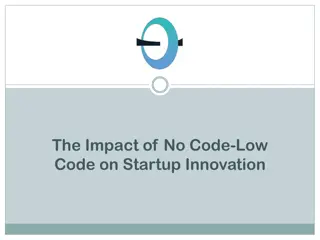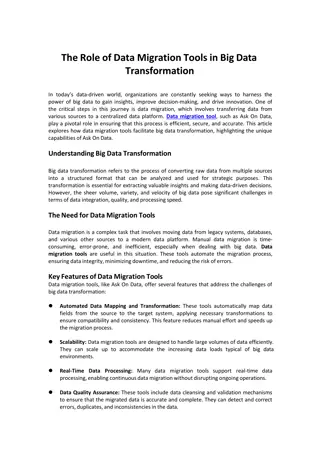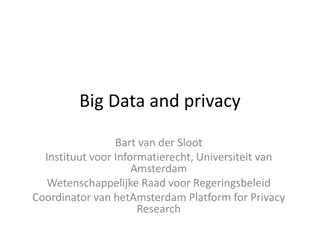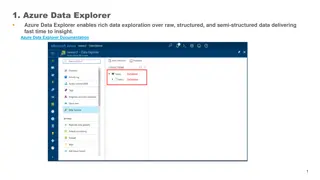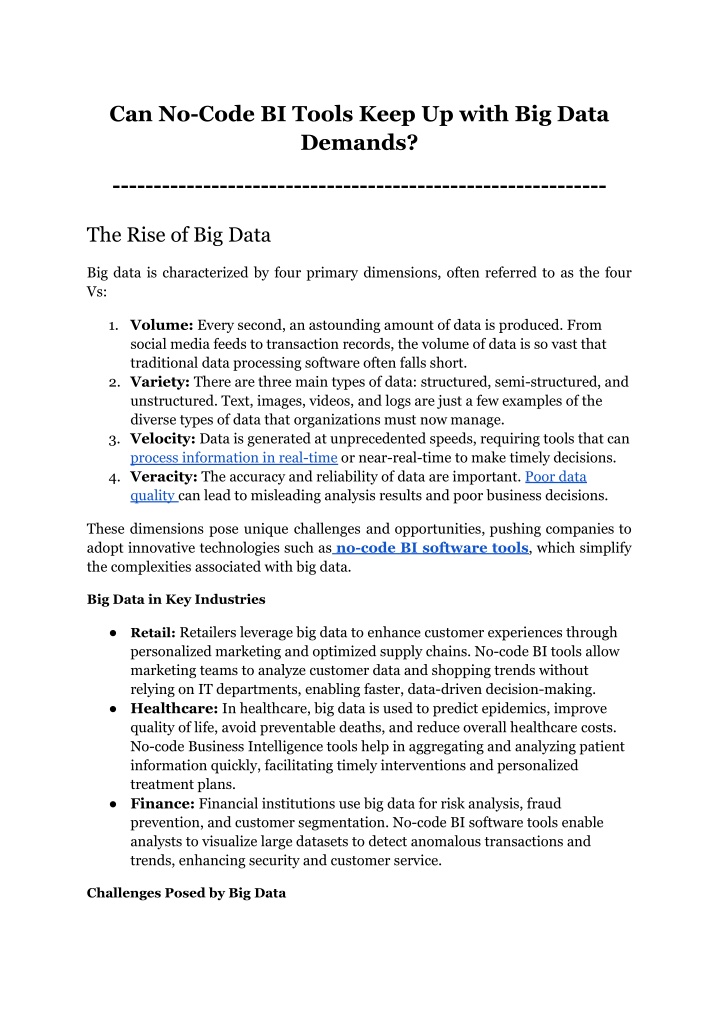
Can No-Code BI Tools Keep Up with Big Data Demands_
In the rapidly evolving landscape of business intelligence, no-code BI tools are becoming increasingly popular for their user-friendliness and accessibility. But can these tools handle the massive and complex datasets that define today's big data needs? This blog delves into the capabilities, advantages, and limitations of No-code BI software tools in managing large volumes of diverse data.
Download Presentation

Please find below an Image/Link to download the presentation.
The content on the website is provided AS IS for your information and personal use only. It may not be sold, licensed, or shared on other websites without obtaining consent from the author. If you encounter any issues during the download, it is possible that the publisher has removed the file from their server.
You are allowed to download the files provided on this website for personal or commercial use, subject to the condition that they are used lawfully. All files are the property of their respective owners.
The content on the website is provided AS IS for your information and personal use only. It may not be sold, licensed, or shared on other websites without obtaining consent from the author.
E N D
Presentation Transcript
Can No-Code BI Tools Keep Up with Big Data Demands? ------------------------------------------------------------ The Rise of Big Data Big data is characterized by four primary dimensions, often referred to as the four Vs: 1. Volume: Every second, an astounding amount of data is produced. From social media feeds to transaction records, the volume of data is so vast that traditional data processing software often falls short. 2. Variety: There are three main types of data: structured, semi-structured, and unstructured. Text, images, videos, and logs are just a few examples of the diverse types of data that organizations must now manage. 3. Velocity: Data is generated at unprecedented speeds, requiring tools that can process information in real-time or near-real-time to make timely decisions. 4. Veracity: The accuracy and reliability of data are important. Poor data quality can lead to misleading analysis results and poor business decisions. These dimensions pose unique challenges and opportunities, pushing companies to adopt innovative technologies such as no-code BI software tools, which simplify the complexities associated with big data. Big Data in Key Industries Retail: Retailers leverage big data to enhance customer experiences through personalized marketing and optimized supply chains. No-code BI tools allow marketing teams to analyze customer data and shopping trends without relying on IT departments, enabling faster, data-driven decision-making. Healthcare: In healthcare, big data is used to predict epidemics, improve quality of life, avoid preventable deaths, and reduce overall healthcare costs. No-code Business Intelligence tools help in aggregating and analyzing patient information quickly, facilitating timely interventions and personalized treatment plans. Finance: Financial institutions use big data for risk analysis, fraud prevention, and customer segmentation. No-code BI software tools enable analysts to visualize large datasets to detect anomalous transactions and trends, enhancing security and customer service. Challenges Posed by Big Data
Big data introduces several challenges, primarily in data management and analysis: 1. Storage: The volume of data requires substantial storage solutions that are both scalable and cost-effective. Cloud storage integrated with no-code Business Intelligence software can offer scalable options without heavy upfront investments. 2. Processing: Processing large datasets quickly is a challenge, especially when the data is complex and varied. No-code BI tools with robust backend architectures can significantly reduce the processing time, providing real-time analytics to support rapid decision-making. 3. Analysis Complexity: Analyzing diverse and massive datasets requires advanced analytical tools and expertise. No-code BI tools democratize data analytics by providing user-friendly interfaces and pre-built analytics models, making complex data analysis accessible to non-experts. Evaluation of No-Code BI Tools in Handling Big Data No-code BI tools are transforming the landscape of data analytics by making complex data analysis accessible to non-technical users. These tools are designed not only to simplify interactions with big data but also to provide robust technical capabilities to manage large datasets efficiently. Let s explore these capabilities and real-world applications through case studies that highlight the efficacy of no-code BI software in various industries. Technical Capabilities to Handle Large Datasets No-code Business Intelligence tools are equipped with advanced data processing engines that allow them to manage and analyze large datasets with ease. These tools typically feature: Data Aggregation and Filtering: No-code BI tools can handle millions of data points by aggregating data and allowing users to apply filters for focused analyses. Performance Optimization: Many no-code BI software tools utilize in-memory data processing, which significantly speeds up the analysis by storing data temporarily in the system's RAM. Scalability: Cloud-based no-code BI solutions offer scalability, enabling businesses to increase their data processing capabilities as their data volume grows without the need for physical infrastructure upgrades. Integration Abilities with Databases and Data Warehouses Integration with various data sources is critical for BI tools to function effectively across organizational data ecosystems. No-code BI tools excel in this area by offering:
Plug-and-Play Connectivity: These tools provide pre-built connectors for a wide range of databases and data warehouses, including SQL databases, NoSQL databases, and cloud-based storage solutions like Amazon S3, Google Cloud Storage, and more. Real-Time Data Sync: No-code Business Intelligence software tools often feature real-time data synchronization capabilities, ensuring that the data displayed is always current, which is crucial for timely decision-making. For more on the user-centric benefits and why your organization might opt for no-code over traditional BI tools, consider exploring the insights in our related blog: "Why Should You Use No-Code Business Intelligence Software?". Limitations of No-Code BI Tools in Handling Big Data While no-code BI tools offer numerous benefits, such as ease of use and accessibility, they come with inherent limitations that can impact their effectiveness in certain scenarios, particularly when dealing with very large or complex datasets. Understanding these limitations is crucial for businesses to make informed decisions when selecting the right BI tools for their needs. Scalability and Performance Limitations One of the primary concerns with no-code BI tools is their ability to scale when confronted with extremely large datasets or complex data processing requirements. Here are some specific challenges: Performance Bottlenecks: No-code BI tools can sometimes struggle with performance issues when handling massive datasets or performing complex, resource-intensive operations. This can lead to longer loading times and delays in data refreshes, which might not be acceptable in environments where real-time data analysis is critical. Limited Handling of Data Complexity: Although no-code Business Intelligence tools are excellent for standard data analysis, they may lack the advanced capabilities needed to manage highly complex data structures or to perform sophisticated statistical or machine learning analyses that require custom coding. Trade-Off Between Ease of Use and Control/Customization No-code BI tools are designed to be user-friendly, often at the expense of deeper functionality and customization: Limited Customization Options: While the simplicity of no-code BI software tools allows for quick deployment and ease of use, it often restricts the ability to perform custom modifications or optimize the system beyond
predefined settings. This can be a significant drawback for organizations with specific needs that cannot be met by standard configurations. Lower Control Over Data Processes: Users of no-code BI tools typically have less control over the backend processes, including data storage, query optimization, and detailed data transformations. This can limit the tool's usefulness for data scientists or analysts who need to fine-tune their data handling for optimal results. Dependency on Vendor for Updates, Features, and Security Using no-code Business Intelligence tools often means relying heavily on the tool's vendor for everything from system updates to new features and security: Dependency on Vendor Updates: Users of no-code BI tools must rely on the vendor to release updates and new features. This can hinder a company's ability to respond to emerging needs or to integrate new technologies that are not supported by the vendor. Security Concerns: Since the security features are also managed by the vendor, organizations have limited visibility and control over how their data is protected. This could raise concerns, especially for industries that are heavily regulated or that handle sensitive information. Comparing No-Code and Code-Based BI Tools: Flexibility, Scalability, and Control Business Intelligence tools are essential for organizations looking to make informed decisions based on their data. The choice between no-code and code-based BI tools can significantly impact the flexibility, scalability, control, and ease of use of the data analysis capabilities of a company. Understanding the differences between these tools is crucial for selecting the right BI solution that aligns with an organization's needs. 1. Flexibility and Control No-Code BI Tools: No-code BI software tools are designed for simplicity and speed, catering primarily to business users who need quick insights without deep technical knowledge. These tools typically offer drag-and-drop interfaces and pre-configured templates, which simplify the process of report creation and data visualization. However, this ease of use often comes at the expense of reduced flexibility and control over the data processing and analysis capabilities. Code-Based BI Tools: Code-based BI tools provide a higher degree of flexibility and control, allowing users to write custom scripts and queries to manipulate data exactly as required. This capability is crucial for performing complex data transformations and integrations that go beyond the capabilities of no-code
solutions. Code-based tools are ideal for data professionals who need to conduct in-depth analytics, create customized data models, or integrate BI capabilities into other software applications. 1. Scalability No-Code BI Tools: While no-code BI tools are improving in terms of scalability, they still face limitations when handling extremely large datasets or very high query loads, which can lead to performance bottlenecks. The scalability largely depends on the underlying architecture of the tool and the infrastructure provided by the vendor, which may not always meet the highest demands of large enterprises. Code-Based BI Tools: Code-based tools often provide better scalability options because they can be finely tuned and optimized for performance by skilled developers. They can handle larger datasets more effectively and are better suited for environments where data grows rapidly or where real-time processing of large data streams is necessary. 1. Learning Curve and Technical Expertise No-Code BI Tools: No-code Business Intelligence tools are specifically designed to be user-friendly, reducing the learning curve significantly. Non-technical users can often start creating reports and dashboards with minimal training, making
these tools highly accessible to business analysts and decision-makers without a background in data science. Code-Based BI Tools: Conversely, code-based BI tools require a considerable amount of technical expertise, including knowledge of programming languages such as SQL, Python, or R. The learning curve is steeper, but this investment in learning pays off with a greater ability to conduct detailed and customized data analysis. Preference of Traditional Developers Traditional developers often prefer code-based BI tools due to several reasons: Customization and Precision: Developers can exert fine control over the data processes and customize the analytics to fit specific requirements, which is less feasible with no-code solutions. Integration Capabilities: Code-based tools can be more easily integrated into existing IT infrastructures and customized to interact seamlessly with other applications, which is crucial in complex enterprise environments. Performance Optimization: Developers have the tools and knowledge to optimize queries and data processing tasks to improve performance, a necessity for handling large scales of data efficiently. Conclusion Are No-Code BI Tools Sufficient for Big Data Demands? As businesses continue to generate vast amounts of data, the choice of the right BI tool becomes crucial. No-code BI tools have demonstrated significant strengths, such as user-friendliness, quick deployment, and accessibility, making them highly appealing to non-technical users who need to make data-driven decisions efficiently. These tools enable companies across various sectors from healthcare to finance to retail to harness the power of big data without the need for extensive technical expertise. However, while no-code BI tools are evolving to handle larger datasets and offer more sophisticated analytical capabilities, there are inherent limitations in terms of scalability, customization, and control compared to their code-based counterparts. Organizations must carefully assess their specific needs, considering not just the volume of data but also the complexity of the analytics required to derive actionable insights. For those looking to explore the capabilities of no-code BI tools, Grow offers a compelling option. Grow's platform is designed to balance ease of use with powerful analytical capabilities, making it an excellent starting point for businesses aiming to leverage the benefits of no-code BI. With Grow's 14-day free trial, companies can
experience firsthand how well these tools integrate with their operations and data systems without any initial investment. To make an informed decision, we encourage prospective users to read through Grow reviews costs and features GetApp, to see how other businesses have successfully implemented Grow to meet their big data needs. This will provide a comprehensive view of why these tools are the future of of BI and how no-code BI tools like Grow can fit into your data strategy.




